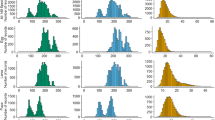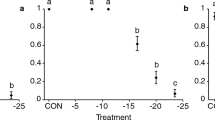Abstract
The occurrence of sub-optimal temperatures during development of immature parasitoids can have important consequences on adult fitness. We investigated the impact of different regimes of low temperature on emergence, differential mortality, longevity and fecundity in Trichogramma brassicae Bezdenko (Hymenoptera: Trichogrammatidae). The host-feeding behaviour of adult females was also measured as an indicator of energy reserve at emergence. Acclimation of 30 days at 10 °C or 24 days at 13 °C allowed T. brassicae immatures to develop with a lower mortality than those exposed directly at 5 °C. Longevity and fecundity of females decreased at a lower rate with acclimation at 10 °C suggesting that acclimation at 13 °C may have depleted the energy reserves of individuals more than acclimation at 10 °C. Short photoperiod exposure during the maternal generation had no effect on progeny’s fitness. We found no difference among the treatments in females’ host-feeding behaviours, in differential mortality at emergence, in female’s mobility and in F1 sex ratio.



Similar content being viewed by others
References
Abd El-Gawad HAS, Sayed AMM, Ahmed SA (2010) Impact of cold storage temperature and period on performance of Trichogramma evanescens Westwood (Hymenoptera: Trichogrammatidae). J Appl Sci Res 6:2188–2195
Ayvaz A, Karasu E, Karabörklü S, Tunçbilek A (2008) Effects of cold storage, rearing temperature, parasitoid age and irradiation on the performance of Trichogramma evanescens Westwood (Hymenoptera: Trichogrammatidae). J Stored Prod Res 44:232–240
Babendreier D, Kuske S, Bigler F (2003) Overwintering of the egg parasitoid Trichogramma brassicae in northern Switzerland. BioControl 48:261–273
Bayram A, Ozcan H, Kornosor S (2005) Effect of cold storage on the performance of Telenomus busseolae Gahan (Hymenoptera: Scelionidae), an egg parasitoid of Sesamia nonagrioides (Lefebvre) (Lepidoptera: Noctuidae). Biol Control 35:68–77
Boivin G (1994) Overwintering strategies of egg parasitoids. In: Wajnberg E, Hassan SA (eds) Biological control with egg parasitoids. CAB International, Wallingford, UK, pp 219–244
Boivin G (2010) Phenotypic plasticity and fitness in egg parasitoids. Neotrop Entomol 39:457–463
Chen W, Leopold RA, Harris MO (2008) Cold storage effect on maternal and progeny quality of Gonatocerus ashmeadi Girault (Hymenoptera: Mymaridae). Biol Control 46:122–132
Colinet H, Boivin G (2011) Insect parasitoids cold storage: a comprehensive review of factors of variability and consequences. Biol Control 58:83–95
Colinet H, Boivin G, Hance T (2007) Manipulation of parasitoid size using the temperature-size rule: fitness consequences. Oecologia 152:425–433
Danks HV (1987) Insect dormancy: an ecological perspective. Biological Survey of Canada, Ottawa, Canada, p 439
Denlinger DL, Lee RE Jr (1998) Physiology of cold sensitivity. In: Hallman GJ, Denlinger DL (eds) Temperature sensitivity in insects and application in integrated pest management. Westview, Boulder, USA, pp 55–96
Dutton A, Bigler F (1995) Flight activity assessment of the egg parasitoid Trichogramma brassicae (Hym.: Trichogrammatidae) in laboratory and field conditions. Entomophaga 40:223–233
Ferracini C, Boivin G, Alma A (2006) Costs and benefits of host feeding in the parasitoid wasp Trichogramma turkestanica. Entomol Exp Appl 121:229–234
Foerster MR, Foerster LA (2009) Effects of temperature on the immature development and emergence of five species of Trichogramma. BioControl 54:445–450
Garcia VP, Wajnberg E, Pizzol J, Oliveira MLM (2002) Diapause in the egg parasitoid Trichogramma cordubensis: role of temperature. J Insect Physiol 48:349–355
Godfray HCJ (1994) Parasitoids, behavioral and evolutionary ecology. Princeton University, Princeton, USA, p 473
Hance T, van Baaren J, Vernon P, Boivin G (2007) Impact of extreme temperatures on parasitoids in a climate change perspective. Annu Rev Entomol 52:107–126
Heimpel GE, Collier TR (1996) The evolution of host-feeding behaviour in insect parasitoids. Biol Rev Camb Philos Soc 71:373–400
Hoffmann AA, Hewa-Kapuge S (2000) Acclimation for heat resistance in Trichogramma nr. brassicae: can it occur without costs? Funct Ecol 14:55–60
Iacob M, Iacob N (1972) Influence of temperature variations on the resistance of the wasp Trichogramma evanescens westwood to storage with a view to field releases. Inst Cerce Prot Plant 8:191–199
Ivanov MF, Reznik SY (2008) Photoperiodic regulation of the diapause of the progeny in Trichogramma embryophagum htg. (Hymenoptera, Trichogrammatidae): dynamics of sensitivity to photoperiod at the immature stages of maternal females. Entomol Rev 88:261–268
Jalali SK, Singh SP (1992) Differential response of four Trichogramma species to low temperatures for short term storage. Entomophaga 37:159–165
Jervis MA, Kidd NAC (1986) Host-feeding strategies in hymenopteran parasitoids. Biol Rev 61:395–434
Jervis MA, Heimpel GE, Ferns PN, Harvey JA, Kidd NAC (2001) Life-history strategies in parasitoid wasps: a comparative analysis of ‘ovigeny’. J Anim Ecol 70:442–458
Laing JE, Corrigan JE (1995) Diapause induction and post-diapause emergence in Trichogramma minutum Riley (Hymenoptera: Trichogrammatidae): the role of host species, temperature, and photoperiod. Can Entomol 127:103–110
Leatemia JA, Laing JE, Corrigan JE (1995) Effects of adult nutrition on longevity, fecundity, and offspring sex ratio of Trichogramma minutum Riley (Hymenoptera: Trichogrammatidae). Can Entomol 127:245–254
Levie A, Vernon P, Hance T (2005) Consequences of acclimation on survival and reproductive capacities of cold-stored mummies of Aphidius rhopalosiphi (Hymenoptera: Aphidiinae). J Econ Entomol 98:704–708
Lewis WJ, Stapel JO, Cortesero AM, Takasu K (1998) Understanding how parasitoids balance food and host needs: importance to biological control. Biol Control 11:175–183
Ma C, Chen Y (2006) Effects of constant temperature, exposure period, and age on diapause induction in Trichogramma dendrolimi. Biol Control 36:267–273
Martel V, Darrouzet T, Boivin G (2011) Phenotypic plasticity in the reproductive traits of a parasitoid. J Insect Physiol 57:682–687
Özder N, Saglam Ö (2005a) Effect of short term cold storage on the quality of Trichogramma brassicae, T. cacoeciae, and T. evanescens (Hymenoptera: Trichogrammatidae). Gt Lakes Entomol 37(3-4):183–187
Özder N, Saglam Ö (2005b) Overwintering of the egg parasitoids Trichogramma brassicae and T. cacoeciae (Hymenoptera: Trichogrammatidae) in the Thrace region of Turkey. J Pest Sci 78:129–132
Pandey RR, Johnson MW (2005) Effects of cool storage on Anagyrus ananatis Gahan (Hymenoptera: Encyrtidae). Biol Control 35:9–16
Pintureau B, Daumal J (1995) Effects of diapause and host species on some morphometric characters in Trichogramma (Hym.: Trichogrammatidae). Experientia 51:67–72
Pitcher SA, Hoffmann MP, Gardner J, Wright MG, Kuhar TP (2002) Cold storage of Trichogramma ostriniae reared on Sitotroga cerealella eggs. BioControl 47:525–535
Pizzol J, Pintureau B (2008) Effect of photoperiod experienced by parents on diapause induction in Trichogramma cacoeciae. Entomol Exp Appl 127:72–77
Rako L, Hoffmann AA (2006) Complexity of the cold acclimation response in Drosophila melanogaster. J Insect Physiol 52:94–104
Reznik SY, Vaghina NP, Voinovich ND (2008) Diapause induction in Trichogramma embryophagum htg. (Hym.: Trichogrammatidae): the dynamics of thermosensitivity. J Appl Entomol 132:502–509
Rivero A, West SA (2002) The physiological costs of being small in a parasitic wasp. Evol Ecol Res 4:407–420
Rundle BJ, Hoffmann AA (2003) Overwintering of Trichogramma funiculatum Carver (Hymenoptera: Trichogrammatidae) under semi-natural conditions. Environ Entomol 32:290–298
Rundle BJ, Thomson LJ, Hoffmann AA (2004) Effects of cold storage on field and laboratory performance of Trichogramma carverae (Hymenoptera: Trichogrammatidae) and the response of three Trichogramma spp. (T. carverae, T. nr. brassicae, and T. funiculatum) to cold. J Econ Entomol 97:213–221
Smith SM (1996) Biological control with Trichogramma: advances, successes, and potential of their use. Annu Rev Entomol 41:375–406
Tezze AA, Botto EN (2004) Effect of cold storage on the quality of Trichogramma nerudai (Hymenoptera: Trichogrammatidae). Biol Control 30:11–16
Uçkan F, Gülel A (2001) The effects of cold storage on the adult longevity, fecundity and sex ratio of Apanteles galleriae Wilkinson (Hym.: Braconidae). Turk J Zool 25:187–191
van Baaren J, Outreman Y, Boivin G (2005) Effect of low temperature exposure on oviposition behaviour and patch exploitation strategy in parasitic wasps. Anim Behav 70:153–163
Withers PC (1992) Comparative animal physiology. Harcourt Brace Jovanovich College, Fort Worth, USA
Zaslavski VA, Umarova TY (1990) Environmental and endogenous control of diapause in Trichogramma species. Entomophaga 35:23–29
Acknowledgments
We thank Josiane Vaillancourt, Danielle Thibodeau and Julie Frenette for supplying insect material and for technical assistance. This research was supported in part by a scholarship from Anatis Bioprotection Inc.
Author information
Authors and Affiliations
Corresponding author
Additional information
Handling Editor: Torsten Meiners
This research is part of the MSc project of Emilie Lessart devoted to the study of the impact of biotic and abiotic factors on the fitness and host feeding behavior in Trichogrammatidae. Dr Guy Boivin is studying the behaviorial and evolutionary ecology of egg parasitoids.
Rights and permissions
About this article
Cite this article
Lessard, E., Boivin, G. Effect of low temperature on emergence, fecundity, longevity and host-feeding by Trichogramma brassicae . BioControl 58, 319–329 (2013). https://doi.org/10.1007/s10526-012-9493-8
Received:
Accepted:
Published:
Issue Date:
DOI: https://doi.org/10.1007/s10526-012-9493-8




